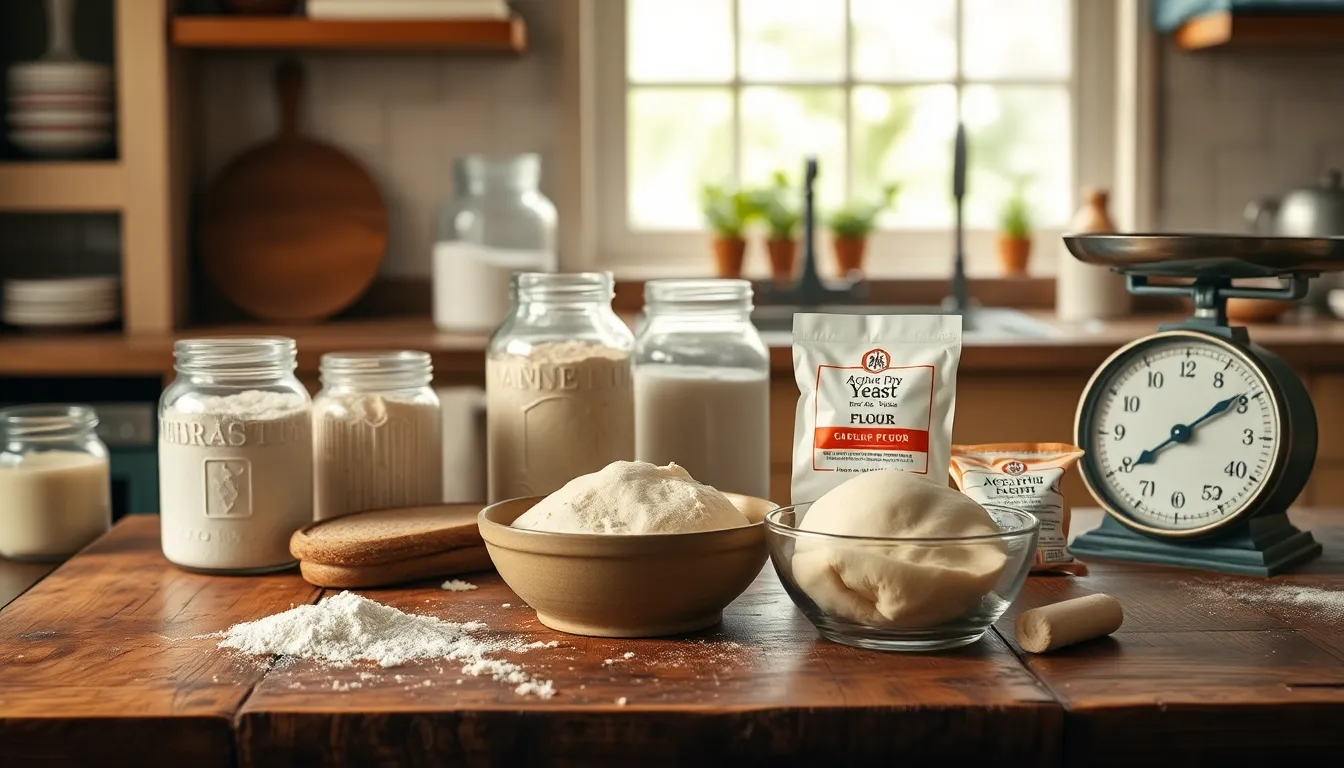In a world filled with instant noodles and microwave meals, traditional baking stands as a delicious rebellion. It’s not just about mixing flour and water; it’s about crafting edible masterpieces that tell stories of heritage, family, and maybe a little bit of flour-dusted chaos. Picture this: the aroma of freshly baked bread wafting through the air, drawing everyone into the kitchen like moths to a flame. Who needs therapy when you can knead dough and punch out your frustrations?
Embracing traditional baking isn’t just a culinary adventure; it’s a journey back to simpler times when food was made with love and a pinch of patience. It’s a chance to swap the store-bought for something that’s truly homemade. So, grab that apron and get ready to unleash your inner baker—because nothing says “I care” quite like a loaf of bread baked with a side of laughter and a sprinkle of nostalgia.
Table of Contents
ToggleOverview of Traditional Baking
Traditional baking encompasses time-honored techniques passed down through generations. Many cultures have unique recipes developed over centuries, each offering a glimpse into its culinary history. Ingredients like flour, water, yeast, and salt form the foundation of countless baked goods, making them accessible yet versatile.
Bakers often celebrate the sensory experience involved in this craft. The process starts with measuring ingredients, progresses to kneading dough, and culminates in the delightful aromas wafting through the kitchen. Connecting these acts to family gatherings heightens the emotional significance of baking.
Numerous baked products reflect regional tastes and preferences. For instance, sourdough bread originated from ancient civilizations and remains popular today. Similarly, pastries like croissants showcase French mastery in technique and flavor.
Traditional baking also promotes mindfulness. Focusing on each step helps individuals relax and cultivate creativity. It transforms the kitchen into a sanctuary where time slows down, allowing bakers to enjoy the simple pleasure of crafting something from scratch.
In the modern culinary landscape, interest in traditional baking is resurging. Many individuals seek to recreate nostalgic flavors reminiscent of home-cooked meals. This revival emphasizes an appreciation for craftsmanship, encouraging a deeper connection to food.
Overall, traditional baking stands as a testament to heritage and community. Sharing baked goods fosters relationships and strengthens bonds. Engaging in this art form transcends mere cooking; it embodies personal expression and nurturing through the creation of beloved recipes.
Essential Ingredients in Traditional Baking

Traditional baking relies on a handful of essential ingredients that contribute to texture, flavor, and structure in baked goods. Each ingredient plays a unique role, ensuring that recipes yield delicious results.
Flour Varieties
Flour serves as the backbone of most baked goods. All-purpose flour offers versatility for various recipes, including bread, cakes, and pastries. Bread flour, with its higher protein content, creates a chewier texture ideal for artisan loaves. Cake flour provides a lighter consistency, perfect for airy cakes and pastries. Whole wheat flour adds depth and nutty flavors, appealing to health-conscious bakers. Specialty flours, such as rye and spelt, introduce unique flavors to traditional recipes, often representing regional preferences.
Yeast and Leavening Agents
Yeast acts as a vital leavening agent in traditional baking, producing carbon dioxide during fermentation and causing dough to rise. Active dry yeast requires activation in warm water, while instant yeast can be mixed directly into dry ingredients. Alternatively, baking soda and baking powder serve as chemical leavening agents, reacting with acidic components to create lift. Sourdough starters, a combination of flour and water, harness wild yeast and contribute distinct flavors to bread. Each leavening agent influences texture, flavor, and baking time for various traditional baked goods.
Techniques and Methods
Traditional baking involves specific techniques and methods that enhance flavor and texture. Mastering these skills contributes to the overall quality of baked goods.
Mixing and Kneading
Mixing ingredients combines them into a cohesive batter or dough. This step typically starts with dry ingredients, followed by wet ones, ensuring even distribution. Kneading, on the other hand, activates gluten in the flour. Glutens provide structure and elasticity to bread and pastries. Bakers often knead dough by folding, pushing, and turning. This process develops strength in the mixture, resulting in a light and airy final product. Timing is crucial; under-kneaded dough can be dense, while over-kneaded dough may become tough.
Baking and Cooling
Baking transforms raw dough into delicious baked goods through heat application. An oven’s temperature and accuracy play vital roles in achieving the desired rise and crust. Typically, bread and pastries require preheating for optimal results. Cooling follows baking, allowing the internal moisture to escape, solidifying the structure. Cooling baked items on wire racks prevents sogginess by promoting air circulation. Proper cooling also enhances flavor, making treats more enjoyable. Timing the cooling process ensures that baked goods maintain their quality and are ready for slicing or serving.
Regional Variations in Traditional Baking
Traditional baking showcases a rich tapestry of regional variations. Each culture brings unique flavors and techniques to the table, enhancing the global landscape of baking.
European Traditions
European baking reflects a diverse array of historical influences and local ingredients. France, for example, is famous for its artisanal breads like baguettes and pastries such as croissants. These delights often use high-quality butter and fine flour to achieve delicate textures. Germany boasts pretzels and hearty rye breads, highlighting robust flavors and a chewy crust. Italy prides itself on pizza and focaccia, emphasizing fresh herbs and olive oil. Each region adapts recipes to its environment, resulting in distinctive tastes and baking styles.
Asian Influences
Asian baking introduces a different set of flavors and techniques. In China, mooncakes signify the Mid-Autumn Festival, combining rich fillings with thin pastry shells. Japan features desserts like matcha chiffon cake, reflecting the country’s affinity for green tea and light textures. India showcases a variety of breads such as naan and paratha, each enriched with spices and regional ingredients. Southeast Asia offers treats like pandan cakes that utilize local flavors for sweetness. These adaptations highlight how traditional baking can unite diverse cultures through shared practices and ingredient choices.
Health Benefits of Traditional Baking
Traditional baking offers numerous health benefits that extend beyond just nutrition. Engaging in the baking process reduces stress, fostering mindfulness and creativity. Measuring ingredients, kneading dough, and watching the transformation in the oven provide therapeutic experiences.
Whole ingredients often feature in traditional baked goods, enhancing nutritional value. Whole grains, used in recipes like whole wheat bread, deliver essential nutrients like fiber and vitamins. Homemade items eliminate preservatives, offering a cleaner alternative to store-bought options.
Social connections arise through sharing baked goods, which cultivates community and strengthens relationships. Participating in baking has the potential to bond families, as they work together to create beloved recipes. Enjoying fresh-baked treats together encourages quality time.
In traditional baking, ingredient quality plays a significant role in overall health. Using seasonal fruits, such as berries, boosts flavor while adding vitamins and antioxidants. Incorporating nuts and seeds enhances protein and healthy fat content, offering balanced nutrition in each bite.
Various gluten-free options continue to increase in popularity, catering to those with dietary restrictions. Alternative flours such as almond flour or coconut flour can create delicious baked items without compromising taste. This inclusivity improves accessibility for diverse dietary needs.
Embracing local ingredients reflects a commitment to health and community. Each region offers unique produce that can enhance the flavor profiles of baked goods while supporting local economies. Traditional baking encourages sustainable practices through the use of fresh, seasonal ingredients.
Baking at home paves the way for healthier choices by controlling sugar and fat content. Modifications in recipes can transform indulgent desserts into lighter versions, making them suitable for everyday enjoyment. From classic cakes to hearty breads, traditional baking promotes health and well-being.
Traditional baking offers a meaningful way to connect with heritage and family. It fosters creativity and mindfulness while bringing the comforting aromas of the kitchen to life. By embracing age-old techniques and regional recipes, individuals can experience the joy of crafting beloved baked goods that resonate with personal and cultural significance.
The health benefits of engaging in this timeless art further enhance its appeal. Homemade creations not only provide a cleaner alternative to processed foods but also encourage quality ingredient choices that support well-being. Whether it’s a loaf of sourdough or a delicate pastry, traditional baking remains a cherished practice that nurtures both body and soul.





